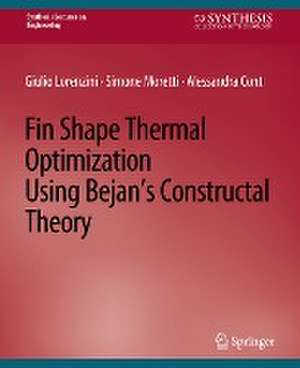Fin-Shape Thermal Optimization Using Bejan's Constuctal Theory: Synthesis Lectures on Engineering, Science, and Technology
Autor Giulio Lorenzini, Simone Moretti, Alessandra Contien Limba Engleză Paperback – 5 apr 2011
Din seria Synthesis Lectures on Engineering, Science, and Technology
-
 Preț: 393.52 lei
Preț: 393.52 lei -
 Preț: 395.92 lei
Preț: 395.92 lei -
 Preț: 321.34 lei
Preț: 321.34 lei -
 Preț: 284.04 lei
Preț: 284.04 lei - 15%
 Preț: 500.59 lei
Preț: 500.59 lei -
 Preț: 397.38 lei
Preț: 397.38 lei - 15%
 Preț: 581.14 lei
Preț: 581.14 lei -
 Preț: 387.75 lei
Preț: 387.75 lei -
 Preț: 320.40 lei
Preț: 320.40 lei - 20%
 Preț: 594.83 lei
Preț: 594.83 lei -
 Preț: 420.02 lei
Preț: 420.02 lei - 20%
 Preț: 588.21 lei
Preț: 588.21 lei - 18%
 Preț: 738.28 lei
Preț: 738.28 lei - 15%
 Preț: 644.95 lei
Preț: 644.95 lei -
 Preț: 329.98 lei
Preț: 329.98 lei -
 Preț: 214.57 lei
Preț: 214.57 lei -
 Preț: 236.41 lei
Preț: 236.41 lei - 20%
 Preț: 331.25 lei
Preț: 331.25 lei -
 Preț: 320.40 lei
Preț: 320.40 lei - 15%
 Preț: 527.97 lei
Preț: 527.97 lei -
 Preț: 420.97 lei
Preț: 420.97 lei - 15%
 Preț: 583.61 lei
Preț: 583.61 lei -
 Preț: 352.63 lei
Preț: 352.63 lei - 15%
 Preț: 527.97 lei
Preț: 527.97 lei -
 Preț: 396.43 lei
Preț: 396.43 lei - 15%
 Preț: 526.35 lei
Preț: 526.35 lei -
 Preț: 270.36 lei
Preț: 270.36 lei - 18%
 Preț: 735.07 lei
Preț: 735.07 lei - 17%
 Preț: 458.17 lei
Preț: 458.17 lei -
 Preț: 386.81 lei
Preț: 386.81 lei -
 Preț: 389.70 lei
Preț: 389.70 lei - 20%
 Preț: 295.74 lei
Preț: 295.74 lei -
 Preț: 358.76 lei
Preț: 358.76 lei - 15%
 Preț: 523.91 lei
Preț: 523.91 lei -
 Preț: 514.29 lei
Preț: 514.29 lei -
 Preț: 413.76 lei
Preț: 413.76 lei -
 Preț: 404.13 lei
Preț: 404.13 lei -
 Preț: 427.71 lei
Preț: 427.71 lei -
 Preț: 390.63 lei
Preț: 390.63 lei -
 Preț: 221.18 lei
Preț: 221.18 lei - 15%
 Preț: 640.06 lei
Preț: 640.06 lei -
 Preț: 399.81 lei
Preț: 399.81 lei - 15%
 Preț: 531.26 lei
Preț: 531.26 lei - 15%
 Preț: 528.80 lei
Preț: 528.80 lei - 15%
 Preț: 529.60 lei
Preț: 529.60 lei
Preț: 386.81 lei
Nou
Puncte Express: 580
Preț estimativ în valută:
74.03€ • 76.100$ • 61.11£
74.03€ • 76.100$ • 61.11£
Carte tipărită la comandă
Livrare economică 14-28 aprilie
Preluare comenzi: 021 569.72.76
Specificații
ISBN-13: 9783031793325
ISBN-10: 3031793323
Ilustrații: XIII, 205 p.
Dimensiuni: 191 x 235 mm
Greutate: 0.39 kg
Editura: Springer International Publishing
Colecția Springer
Seriile Synthesis Lectures on Engineering, Science, and Technology, Synthesis Lectures on Engineering
Locul publicării:Cham, Switzerland
ISBN-10: 3031793323
Ilustrații: XIII, 205 p.
Dimensiuni: 191 x 235 mm
Greutate: 0.39 kg
Editura: Springer International Publishing
Colecția Springer
Seriile Synthesis Lectures on Engineering, Science, and Technology, Synthesis Lectures on Engineering
Locul publicării:Cham, Switzerland
Cuprins
General Introduction.- General Overview on Heat Transfer.- Conservation Equations.- Dimensionless group.- Units and conversion factors.- Overview of heat transfer on extended surfaces.- State of the art in the T-Shaped Fins.- Thermal exchange basis.- T-Shaped fins.- Y-Shaped fins.- Modular systems of Y-Shaped fins.- Heat removal vs Pressure drops.- Conclusions.
Notă biografică
Giulio Lorenzini is Full Professor of Environmental Technical Physics at the University of Parma, Italy. A M.Sc. graduate in Nuclear Engineer and Ph.D. in Nuclear Engineering (titles both achieved at Alma Mater Studiorum-University of Bologna, Italy), he is author of some 150 scientific publications, most of which are scientific papers published in international peer reviewed journals and research monographies. He is currently interested in the following: optimization methods in heat transfer and fluid dynamics, Bejan's Constructal theory, bio-fluid dynamics, analytical and numerical modelling of natural phenomena.Simone Moretti achieved his Ph.D. title in Agricultural Engineering in 2010 at Alma Mater Studiorum-University of Bologna, Italy. He is currently active in heat exchange research projects applied to industrial systems. His main research interests focus on fluid-dynamic and heat exchange problems faced through CFD and analytical modelling approaches, especially in relation to the use of finned surfaces and optimized heat exchanging profiles. On these topics, he published several papers in leading journals and conferences and is well trained in Bejan’s Constructal theory applications.Alessandra Conti is a Ph.D. student in Energetic and Nuclear Engineering at Alma Mater Studiorum-University of Bologna. She earned her M.Sc. degree in Nuclear Engineering in 2007 at the University "La Sapienza" of Rome. Her current research interests are the following: CFD simulation of blood flow in human arteries, CFD modelling of sprinkler dynamics, and thermal fluid-dynamic optimization.
